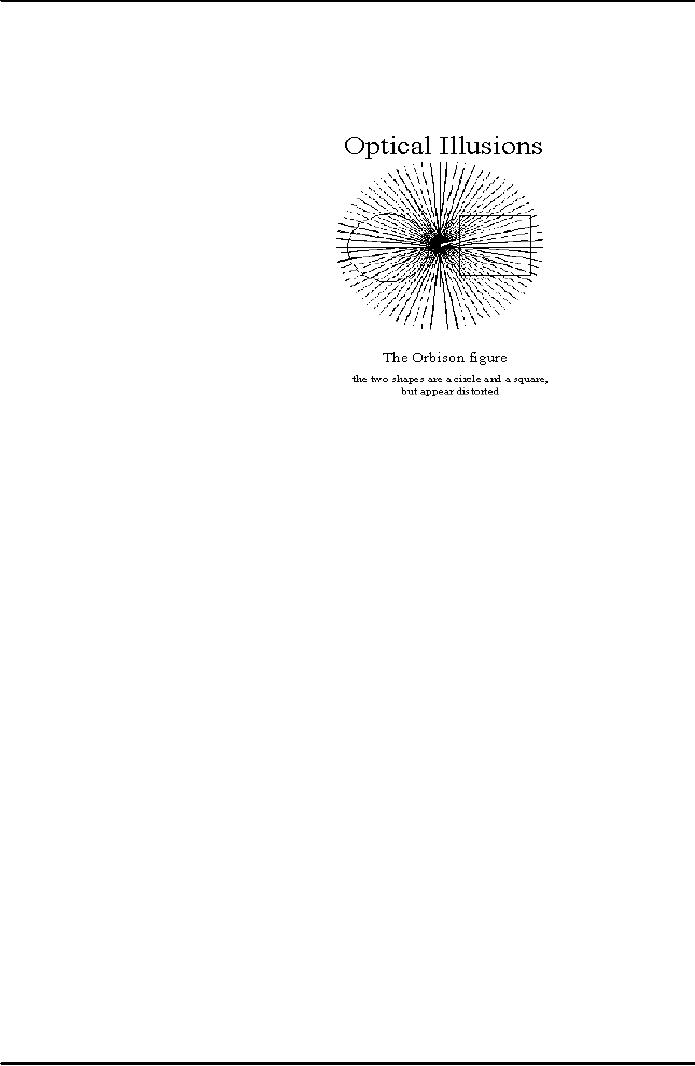 |
PERCEPTION II:Depth Perception, Relative Height, Linear Perspective |
| << PERCEPTION I:Max Wertheimer, Figure and Ground, Law of Closure |
| ALTERED STATES OF CONSCIOUSNESS:Electroencephalogram, Hypnosis >> |

Introduction
to Psychology PSY101
VU
Lesson
18
PERCEPTION
II
Depth
Perception
�
Depth
perception is the perceptual
tendency/ ability to see
objects in three dimensions,
although
the image that falls on
the retina of the eye is
two-dimensional; thus enabling
us
to
perceive distance.
�
"Depth
Perception" is the skill to perceive
depth and distance e.g. we
are able to judge the
distance
of
the incoming car, height of the
cliff or of a roof top, size
of an object, weight of a sand bag
etc,
in
a glance, just by having a look at
it.
�
This
sort of perception is largely due to the fact
that we have two eyes
which are slightly
distant
from
each other, so the brain
integrates the two slightly
different images and
combines them into
one
consolidated view; However the
differences in images or `Binocular
Disparity' is not
ignored
by
the brain.Eleanor Gibson and Richard
Walk discovered this phenomena in
1960 by using the
miniature
cliff with a drop- off
covered by sturdy glass.
�
Placed
the young infants of 6- 14 months at the edge of
visual cliff. Their mothers
motivated them
to
crawl on the glass, but most
of them refused to do so, indicating
that they could perceive
depth__
this may be due to the fact that they
learned to perceive depth in the crawling
age.
Physiological
depth cues are
formed by our visual system
with the help of muscular
movements or
adjustments.
It is yet difficult to tell
how these cues contribute to
the depth perception. The
adjustments,
which the eyes and eye
muscles make, are assumed to
be of weak nature. These
include:
accommodation
and convergence.
The
psychological depth cues: are
based on the interpretation and
analysis of the retinal image
that is
caused
by the working of the visual cortex in the brain.
Depth
Cues to Perception
There
are two important cues
for the perception of depth. These
include:
I.
Monocular cues for depth
perception.
II.
Binocular cues for depth
perception.
I.Monocular
Cues for Depth
Perception
�
Also
known as " pictorial cues"
because painters use these
cues in order to tell
about
depth;
these lead to three- dimensional
information.
�
These
generate the ability to judge
distance and depth such as
linear perspective and
interposition
with only one
eye.
�
Depth
and location can be
perceived with single eye
also.
i.
Relative motion
�
A
monocular cue for perceiving
depth and distance in which
when
we
move, the objects at
different distances change
their relative
positions
with the visual image___
with those that are
closest seem
to
be moving faster.
Relative
Size
The
monocular cue for depth perception in
which we assume that the two
objects are similar in size,
the
one
that make the smaller image
appears to be more distant.
Interposition
A
monocular cue for perceiving depth in
which the nearer objects
partially block/ hinder our
image of the
more
distant objects.
Relative
Height
�
A
monocular cue to depth perception and
distance in which higher objects
appear to be more
distant.
�
Can
be explained by doing practically as we
are moving in car, train,
bus etc. Fixate your gaze
at
some
point (fixation point)___
say a tree, __ the objects
that are closer than the
tree seems to be
moving
backwards and also seem to
move faster. The objects
that are beyond the fixation
point
108

Introduction
to Psychology PSY101
VU
seem
to move along but at lower speed
and seem as farther away.
Brain has the capability to
compute
these speed and distance
clues in order to perceive
distances.
Linear
Perspective
�
The
monocular cue for the perception of depth
and distance in which two
parallel lines seem to be
converging
at some point indicating
increasing distance.
�
Rail
road tracks, highway tracks etc
appear to be converging at some distance
and so, contribute to
the
rail-
crossing accidents by making people to
over estimate the train's distance: a
massive train size
makes
the perception that it is moving
slowly.
Relative
Brightness
A
monocular cue for depth perception in
which the dimmer objects seem to be
more distant.
Nearby
objects seem to reflect more
light than the farther ones.
When going for a walk in a
thick-fog
morning,
one may judge distance
wrongly as due to fog the
objects may be perceived to be
farther than they
do
on the clear shiny morning.
That is why they contribute to
increasing accidents.
Light
and Shadow
Perceptual
phenomenon for the perception of depth
and distance in which when
light strikes an irregular
object,
certain parts are brightly
illuminated whereas others
lay in shadow. These
shadowed parts tell
us
about
the depth of the parts concerned___
painters use this phenomenon when
portraying something on
the
canvas such as human face
and its various
structures.
Texture
Gradient
An
American psychologist, James J. Gibson
was the ever first
individual who emphasized
the
importance
of texture gradient for
perceiving depth.
Mainly
applied to textures (structures) of
surfaces and arises when we
observe the surface when in
slant
rather
than from a straight angle or
from above. Pictorial
Cues for Depth
Perception
Monocular
cues are used for the
perception of depth and
distance
�
We
can get an extensive 3-D
impression in 2-D pictures on a
flat surface
Atmospheric
Perspective
Particles
and vapors in the atmosphere
result/ cause the scattering of
light that makes a very
distant
surface
appear hazy.
The
other techniques they use
are;
a.
Occlusion:
near
objects overlap far
surfaces.
b.
Relative
height and size: objects
further away from the
horizon seem nearer and
larger
objects
seem closer.
c.
Linear
perspective: provides a
strong cue to distance that
can effect perception.
d.
Shading:
provides a
cue for shape rather than
distance.
Motion
Parallax
The
change in the position of the retinal
image with the side-to-side movement of
the head; providing a
cue
to
the distance.
Occurs
when objects are at
different distances and we
are also moving at different
rates when in motion.
The
object nearer to the person appears to
move backward but the more distant
objects appears to be
static
as
we move. The rate of an
object's movement provides a cue to its
distance.
Although
motion plays an important
role in depth perception, the perception of
motion is an important
phenomenon
in its own right. It allows
a baseball outfielder to calculate the
speed and trajectory of a
ball
with
extraordinary accuracy. Automobile drivers rely on
motion perception to judge the speeds of
other cars
and
avoid collisions. A cheetah
must be able to detect and
respond to the motion of antelopes,
its chief
prey,
in order to survive.
How
does your brain know which
movement on the retina is due to your own
motion and which is due
to
motion
in the world? Understanding that distinction is the
problem that is faced by
psychologists who want
to
explain motion perception.
One
explanation of motion perception involves a form of
unconscious inference. That
is, when we walk
around
or move our head in a particular way, we
unconsciously expect that
images of stationary objects
will
109

Introduction
to Psychology PSY101
VU
move
on our retina. We discount such movement on the retina
as due to our own bodily
motion and
perceive
the objects as stationary.
Psychologist
James J. Gibson's explanation of motion perception
was too complicated. He
reasoned that
perception
does not depend on internal
thought processes. He thought,
instead, that the objects in
our
environment
contain all the information necessary
for perception e.g. aerial
acrobatics of a fly. Clearly, the
fly
is a master of motion and
depth perception, yet few people would
say the fly makes
unconscious
inferences.
Gibson identified a number of cues
for motion detection, including the
covering and uncovering
of
background. Research has shown
that motion detection is, in
fact, much easier against a
background.
Thus,
as a person moves in front of you,
that person first covers
and then uncovers portions
of the
background
and this reflects
movement.
People
may perceive motion when
none actually exists. For
example, motion
pictures are
really a series of
slightly
different still pictures
flashed on a screen at a rate of 24
pictures, or frames, per
second. From this
rapid
succession of still images,
our brain perceives fluid
motion--a phenomenon known as
stroboscopic
movement.
Binocular
Cues for Depth
Perception
�
The
ability to judge distance
and depth such as retinal
disparity and convergence with
two eyes,
which
are slightly apart from
each other.
�
Our
eyes are slightly apart
from each other having a
distance of about 2 � inches or 6 cm, so
the
images
that fall on the two retinas
are slightly
different.
�
These
two slightly different
images are then integrated
and processed by the brain, but it
does not
ignore
the possibility of difference in images__
known as " binocular
disparity".
i.
Retinal/
Binocular Disparity
�
The
cue to depth perception, the greater the
disparity (difference) between the
two
images
the retinas receive of an object, the
closer the object seems to us___
this
disparity
allows the brain to judge
distance.
�
This
can be proved with the help
of simple experiments done by you. i.e.
hold a
pencil
directly in front of your
nose; the retinas of yours
will receive
different
views/
images. Now make them closer
firstly to one eye and
then to the other. At
greater
distance, the disparity is
smaller.
�
This
discrepancy of the two images
that falls on the retinas
varies with respect
to
the
distance from which the object is being perceived___
used for determining
distance
e.g. if we see two objects
in which one is considerably
closer than the
other,
the retinal disparity will be greater
and we perceive the greater
depth
between
the two.
�
On the
contrary, if the two objects were at
similar distance, the retinal
disparity
will
be minor/ smaller and we
perceive the objects at similar
distance.
�
Movie
directors use these
phenomena in order to create
depth illusions by using
two
cameras, spaced highly
apart, to produce slightly different
images, each image
for
each eye.
�
In
3-D movies, the two images
are presented simultaneously
which produces a
double
image; special glasses are
worn for this purpose to
provide us with the
genuine
sense of the depth
phenomena.Convergence
and Accommodation
A
binocular cue for depth
perception that illustrates,
that when we assume that
the two objects
are
of
same size, the one
that produces a relatively smaller
image will be perceived as
distant.
It
is a neuromuscular cue in which the
more the eyes converge
inwards, the nearer the object
seems.
The
eye lens becomes thicker
due to the activation of ciliary muscles
to focus on the nearer object____
the
degree
of activation of ciliary muscles gives us
the cue to depth.
Convergence
and accommodation are only
effective at close distances and
can tell only the distance
to a
single
object in the visual field.
Selective
Attention
�
Perceptual
process in which the person
chooses the stimulus which he is
interested in; paying
attention
to only the stimulus of
interest.
110

Introduction
to Psychology PSY101
VU
�
Humans
give attention to the objects that
are exceptionally bright, loud,
novel, or high in
contrast___
we are also motivated to give
attention to the objects that
are meaningful as well as
relevant
e.g. if we are thirsty, we
will give more attention to
water and the like.
�
Advertisers
extensively use this phenomena of
selective attention using
bright contrasts,
high
volumes
and more rapid speech than
usual__ and most importantly
broadcast at that time when
people
are particularly sensitive to their
content e.g. the food- related
ads are shown at lunch
or
dinner
times.Stroop
Task
�
Difficult
and frustrating exercise in
which one is confronted with
two powerful and
competing
stimuli___
the meaning of the word and the
colors in which they are
written e.g. I LIKE YOU,
if
written
in red ink.
�
In
these cases, it has been
observed the people pay more
attention to the reading/ content of
the
stimulus
rather than the color from which it
has been written (because
they are experienced
with
reading
than with naming
colors).
b.
Dichotic Listening
�
A
procedure in which individual
wears earphones in which
different messages
are
sent
to each ear at the same
time.
�
After
hearing the stimuli, the individual is
asked to reproduce them aloud as
it
comes
to one ear: " shadowing".
�
In this
process, individual can
easily identify the talking
person as man or
woman
and
whether change in voices takes
place during the message or
not.
�
Experiments
suggest that although people
pay full attention to one
stimulus at a
time,
they also pay some level of
attention to the other stimuli as well;
it shows the
possibility
of learning something although being
unaware of it.The phenomenon
of
selective attention is of particular importance
for the people who have to constantly
monitor e.g.
such
as pilots, traffic controllers, rescue
workers, and firemen.
Form-Perception
�
A
perceptual phenomenon in which we
perceive the shape, form or pattern of
any
object___
give name to objects as house,
tree, table, chair
etc
�
Mainly
it involves two important
principles:
�
Figure-
ground relationship
�
Contours
Figure-
Ground Relationship
�
Our
perceptual tendency to see
objects with the foreground as
well as the
background___
the object is being recognized with
respect to its back ground
e.g.
Black
board and chalk, car parked
in front of a wall, painting against the
wall etc.
�
Contrasting
figures and their grounds
are early and quickly
perceived
�
It is a
vise- versa relationship i.e.,
figure cannot be observed without a
ground and
ground
cannot be recognized without having a
figure.
Contours
�
Perceptual
phenomenon in which we are able to
maintain a difference of the form from
its
background
due to the perception of contours e.g. In observing
the paper, which has two
colors,
white
and black__ there is no contour at all.
But as it becomes lighter rather
than becoming dark, a
person
can simply identify the difference. And
when the difference is much apparent, we
simply
divide
into two parts as light
and dark and skip different
shades as lighter or darker____
where
brightness
changes abruptly, we perceive
contours.
Motion
Perception
�
Motion
simply means the relative/ progressive
change in the position of the person in
space with
time.
Objects cannot be perceived fully when in
motion. It is also difficult
due to the fact that
our
eyes
cannot follow the moving object with
great precision and efficiency
all the time.
111

Introduction
to Psychology PSY101
VU
Relative
Motion
�
While
looking at moving automobiles, the
ones that are nearer
seem to be moving more
rapidly
than
those at a moderate distance,
and those that are
more distant seem to be moving
along.
�
Relative
motion can also be
interpreted through experience,
when one can fairly
tell the speed of a
train
or a bus by noticing outside the
window as to how rapidly the
nearby objects are
passing.
Radical
Motion
�
A movement
directly towards or away from the
observer. Continuous and
radical motion is being
perceived
when the retinal image continuously
changes.
�
The
change in size of the retinal
image gives the perception of
motion.
Perceptual
Constancy
�
A
perceptual tendency to perceive object as
unchanging in size, shape,
color, lightness etc., even
though
changes
in illumination and retinal
image do take place.
There
are a number of constancies identified by
psychologists
I.
Lightness
Constancy:
Means that the object's
lightness or brightness remains the
same in
spite
of changes in illumination.
Lightness
constancy illustrates an important
perceptual principle: Perception is relative.
Lightness
constancy
may occur because the white
piece of paper reflects more
light than any of the other
objects
in
the room--regardless of the different lighting
conditions. Another explanation, proposed by
19th-
century
German physiologist Hermann von
Helmholtz, is that we unconsciously
take the lighting of the
room
into consideration when judging the
lightness of objects.
II
.Color
Constancy:
Closely related with
lightness constancy and
refers to the perception of color
of
the
object remaining the same in spite of
changes in lighting conditions.
Color
constancy can be seen if one
has worn a pair of
sunglasses with colored lenses. In
spite of the
fact
that the colored lenses change the
color of light reaching your
retina, you still perceive
white
objects
as white and red objects as
red. The explanations for
color constancy parallel those
for lightness
constancy.
One proposed explanation is that because
the lenses tint everything with the
same color, we
unconsciously
"subtract" that color from
the scene, leaving the original
colors.
III.
Shape
Constancy:
Means the shape of the object remains the
same in spite of some
changes in its
orientation.
To
understand shape constancy,
hold a book in front of your
face so that you are
looking directly at the
cover.
The rectangular nature of the
book should be very clear. Now, rotate
the book away from you
so
that
the bottom edge of the cover is
much closer to you than the
top edge. The image of the
book on
your
retina will now be quite
different. In fact, the image
will now be trapezoidal,
with the bottom edge
of
the book larger on your retina
than the top edge. (Try to
see the trapezoid by closing one
eye and
imagining
the cover as a two-dimensional shape.) In
spite of this trapezoidal retinal image,
you will
continue
to see the book as rectangular. In
large measure, shape
constancy occurs because
your visual
system
takes depth into
consideration.
IV.
Size Constancy:
refers to our ability or
tendency to perceive objects as remaining
of the same size
despite
having distance from the
observer.
When
an object is near to us, its
image on the retina is large. When
that same object is far
away, its
image
on the retina is small. In spite of the
changes in the size of the retinal
image, we perceive the
object
as of the same size. For
example, when you see a
person at a great distance
from you, you do not
perceive
that person as very small. Instead,
you think that the person is
of normal size and far
away.
Similarly,
when we view a skyscraper from
far away, its image on
our retina is very small--yet we
perceive
the building as very large.
Visual
Illusion
�
Also
known as optical
illusion.
Illusion
is misperception, or false
perception.
�
It
is when the physical stimulus constantly
and persistently produces
error in perception.
�
There
are various types of
illusion of which the most
famous are as
follows;
112

Introduction
to Psychology PSY101
VU
i.Muller-
Lyer Illusion
The
visual illusion in which the
two lines of the same
lengths appear different
because of the change in
position
of arrows at each end of two
lines__ arrows pointing out
appear shorter than the
arrows
pointing
inwards.
Causes
of Illusions
Sensory
deficits and defects
Readiness
and expectation
Atmospheric
variables
Effect
of drugs
Artistic
manipulation
113
Table of Contents:
- WHAT IS PSYCHOLOGY?:Theoretical perspectives of psychology
- HISTORICAL ROOTS OF MODERN PSYCHOLOGY:HIPPOCRATES, PLATO
- SCHOOLS OF THOUGHT:Biological Approach, Psychodynamic Approach
- PERSPECTIVE/MODEL/APPROACH:Narcosis, Chemotherapy
- THE PSYCHODYNAMIC APPROACH/ MODEL:Psychic Determinism, Preconscious
- BEHAVIORAL APPROACH:Behaviorist Analysis, Basic Terminology, Basic Terminology
- THE HUMANISTIC APPROACH AND THE COGNITIVE APPROACH:Rogers’ Approach
- RESEARCH METHODS IN PSYCHOLOGY (I):Scientific Nature of Psychology
- RESEARCH METHODS IN PSYCHOLOGY (II):Experimental Research
- PHYSICAL DEVELOPMENT AND NATURE NURTURE ISSUE:Nature versus Nurture
- COGNITIVE DEVELOPMENT:Socio- Cultural Factor, The Individual and the Group
- NERVOUS SYSTEM (1):Biological Bases of Behavior, Terminal Buttons
- NERVOUS SYSTEM (2):Membranes of the Brain, Association Areas, Spinal Cord
- ENDOCRINE SYSTEM:Pineal Gland, Pituitary Gland, Dwarfism
- SENSATION:The Human Eye, Cornea, Sclera, Pupil, Iris, Lens
- HEARING (AUDITION) AND BALANCE:The Outer Ear, Auditory Canal
- PERCEPTION I:Max Wertheimer, Figure and Ground, Law of Closure
- PERCEPTION II:Depth Perception, Relative Height, Linear Perspective
- ALTERED STATES OF CONSCIOUSNESS:Electroencephalogram, Hypnosis
- LEARNING:Motor Learning, Problem Solving, Basic Terminology, Conditioning
- OPERANT CONDITIONING:Negative Rein forcer, Punishment, No reinforcement
- COGNITIVE APPROACH:Approach to Learning, Observational Learning
- MEMORY I:Functions of Memory, Encoding and Recoding, Retrieval
- MEMORY II:Long-Term Memory, Declarative Memory, Procedural Memory
- MEMORY III:Memory Disorders/Dysfunctions, Amnesia, Dementia
- SECONDARY/ LEARNT/ PSYCHOLOGICAL MOTIVES:Curiosity, Need for affiliation
- EMOTIONS I:Defining Emotions, Behavioral component, Cognitive component
- EMOTIONS II:Respiratory Changes, Pupillometrics, Glandular Responses
- COGNITION AND THINKING:Cognitive Psychology, Mental Images, Concepts
- THINKING, REASONING, PROBLEM- SOLVING AND CREATIVITY:Mental shortcuts
- PERSONALITY I:Definition of Personality, Theories of Personality
- PERSONALITY II:Surface traits, Source Traits, For learning theorists, Albert Bandura
- PERSONALITY III:Assessment of Personality, Interview, Behavioral Assessment
- INTELLIGENCE:The History of Measurement of Intelligence, Later Revisions
- PSYCHOPATHOLOGY:Plato, Aristotle, Asclepiades, In The Middle Ages
- ABNORMAL BEHAVIOR I:Medical Perspective, Psychodynamic Perspective
- ABNORMAL BEHAVIOR II:Hypochondriasis, Conversion Disorders, Causes include
- PSYCHOTHERAPY I:Psychotherapeutic Orientations, Clinical Psychologists
- PSYCHOTHERAPY II:Behavior Modification, Shaping, Humanistic Therapies
- POPULAR AREAS OF PSYCHOLOGY:ABC MODEL, Factors affecting attitude change
- HEALTH PSYCHOLOGY:Understanding Health, Observational Learning
- INDUSTRIAL/ORGANIZATIONAL PSYCHOLOGY:‘Hard’ Criteria and ‘Soft’ Criteria
- CONSUMER PSYCHOLOGY:Focus of Interest, Consumer Psychologist
- SPORT PSYCHOLOGY:Some Research Findings, Arousal level
- FORENSIC PSYCHOLOGY:Origin and History of Forensic Psychology